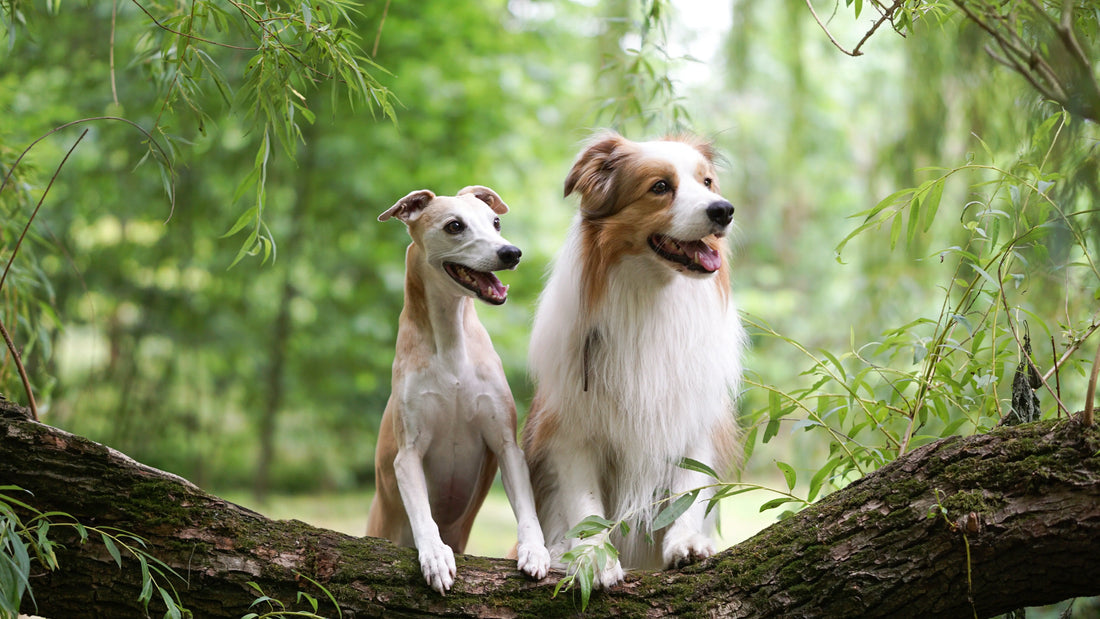
How do dogs' senses compare to ours?
Share
How Dogs Experience the World: The Science of Dog Senses
Our dogs see, hear, smell, and taste the world very differently to us.
We recently wrote about how dogs aren’t limited to seeing the world in black and white, that’s a myth which got us thinking about the other ways in which Rufus and Louie experience our walks differently. Humans rely heavily on our vision, but dogs depend on a range of senses, each adapted to help them navigate their environment in unique ways. Here’s how dogs’ senses compare to ours and what makes their perception so special.
Sight: Seeing the world through a different lens
While humans see the world in a full spectrum of colours thanks to three types of colour receptors in our eyes, dogs have only two. This means they perceive colours in a more limited range, similar to red-green colour blindness in humans. For dogs, the world consists mostly of shades of blue, yellow, and grey. They may struggle to differentiate between reds and greens, which can appear as dull browns or greys.
However, what dogs lack in colour vision, they make up for with other visual strengths. Dogs have better motion detection and night vision than humans, thanks to a higher number of rod cells in their retinas, which are sensitive to low light. This makes dogs more adept at spotting movement in dim conditions, which would have been crucial for hunting in their wild past.
Hearing: Picking up on what we can’t
Dogs' hearing is much more acute than ours. While humans can hear sounds up to about 20,000 Hz, dogs can detect frequencies as high as 65,000 Hz. This means they can hear higher-pitched sounds, including many that are completely inaudible to us, such as the squeak of a dog whistle.
Dogs can also move their ears independently, which helps them pinpoint the exact location of a sound. This heightened sense of hearing allows dogs to pick up on subtle noises from a distance, whether it’s the rustle of a small animal in the bushes or a visitor approaching the house long before you’ve heard anything.
Smell: A nose like no other
If there’s one area where dogs truly excel, it’s their sense of smell. A dog’s olfactory system is estimated to be 10,000 to 100,000 times more sensitive than ours. While humans have about five million scent receptors in their noses, dogs have around 300 million, giving them an extraordinary ability to detect even the faintest of odours.
This remarkable sense of smell allows dogs to perform tasks that are impossible for us, such as detecting drugs, explosives, and even medical conditions like cancer or diabetes. It’s also why dogs can easily recognise other animals and people by scent alone, and why they love to sniff everything when out for a walk, it’s how they gather information and create a mental image of their surroundings.
Taste: Not quite as refined
While dogs have an extraordinary sense of smell, their sense of taste is less developed compared to ours. Humans have around 9,000 taste buds, while dogs have only about 1,700. This means that dogs don’t taste food in the same way we do, and their preferences are often driven more by smell and texture than by taste itself.
However, dogs do have a unique taste sensitivity to water. They possess special taste buds on the tips of their tongues that can detect the flavour of water, which is particularly useful for maintaining hydration. Beyond this, dogs are attracted to foods with strong scents and high fat content, which explains their love for treats with pungent aromas.
Touch: A sense of connection
Touch is an important sense for dogs, and it begins right from birth when puppies rely on touch from their mother and littermates. While dogs may not experience touch in exactly the same way we do, they are very sensitive to it, especially in areas like the face, ears, and paws.
Dogs use their sense of touch to communicate with humans and other dogs, whether it’s through a nudge of the nose, leaning in for a cuddle, or play-fighting with other dogs. Regular, gentle touch from their owners can also help reduce anxiety and strengthen the bond between dog and human.
A sensory world unlike our own
Dogs rely on a combination of these senses to interact with their environment. While their world may appear less colourful, their ability to hear higher frequencies, detect faint scents, and perceive touch allows them to gather information in ways we can only imagine. Understanding how dogs experience the world helps us appreciate why they behave the way they do, whether it’s sniffing every blade of grass, barking at sounds we can’t hear, or responding to your voice even when you’re out of sight.
The fact our dogs see, hear, smell, and taste the world differently, but this is exactly what makes them so special. Their unique sensory abilities allow them to perceive aspects of the world that are beyond our reach, giving them a perspective all their own. So, the next time you see your dog’s ears perk up, watch them sniffing excitedly, or notice their nose twitching, remember, they’re experiencing a world that’s richer and more complex than we can imagine.
Because understanding your dog is just the start, give them the nutrition they need to live healthier, happier lives for longer. Discover our supplements.
